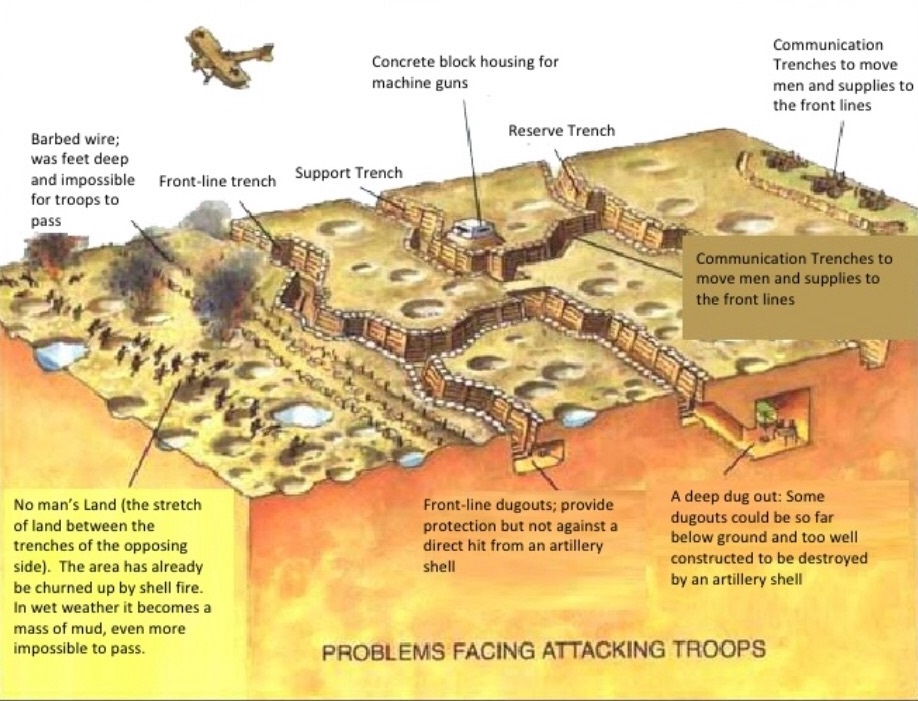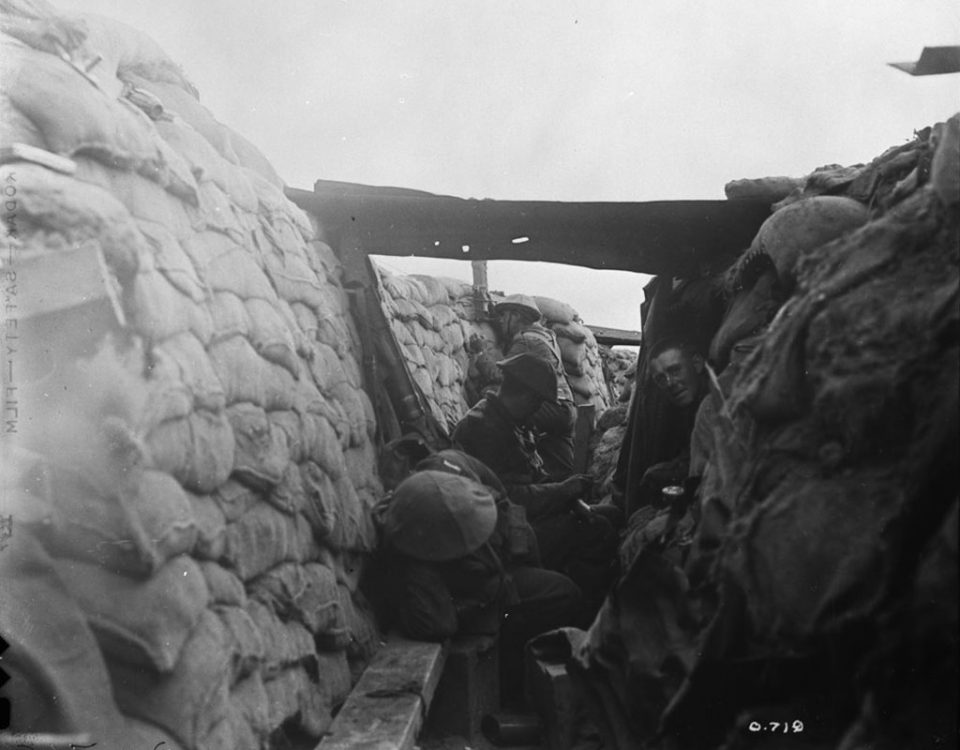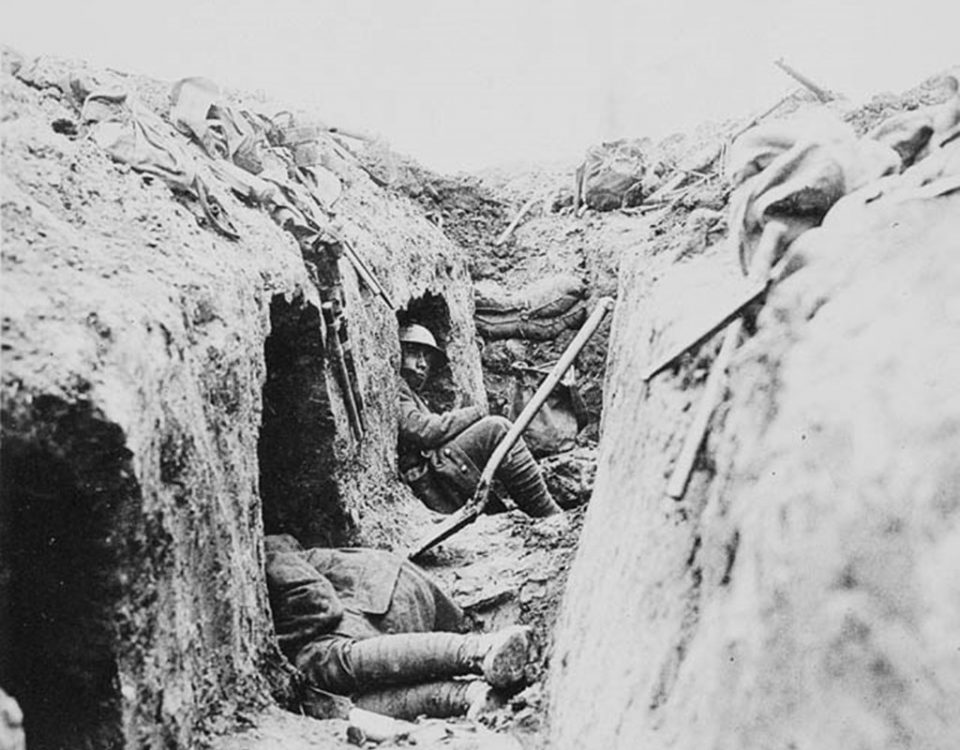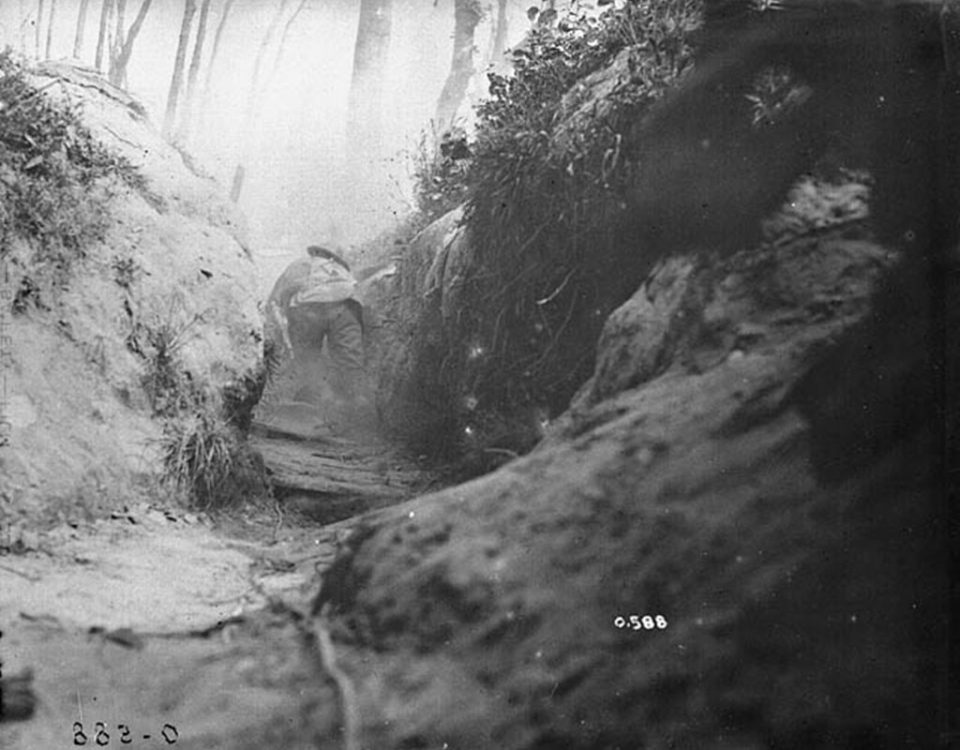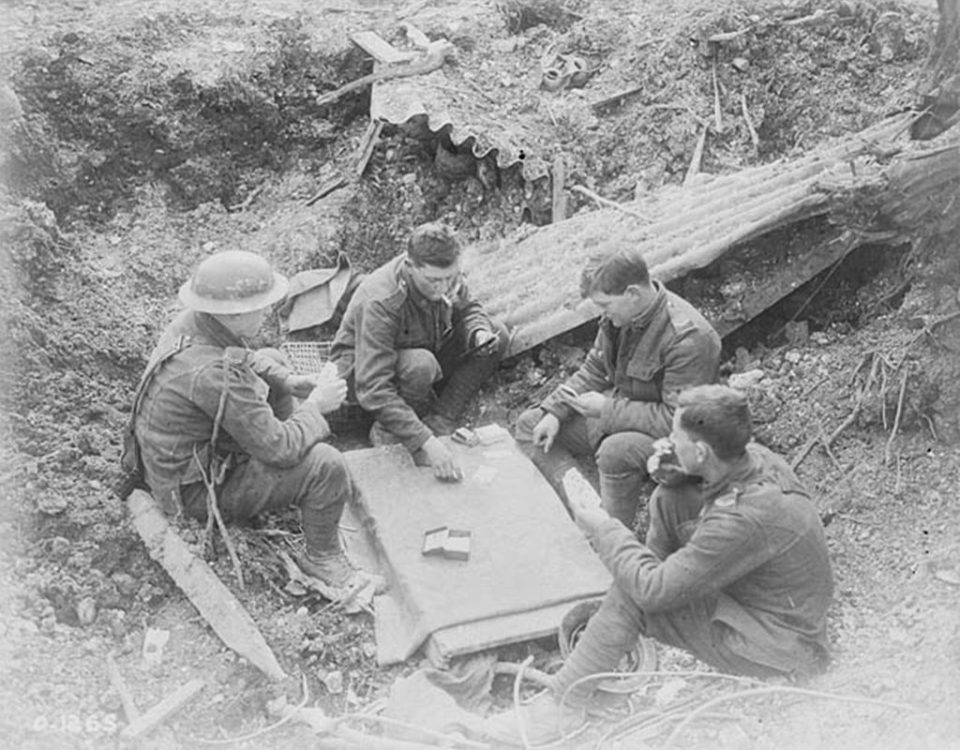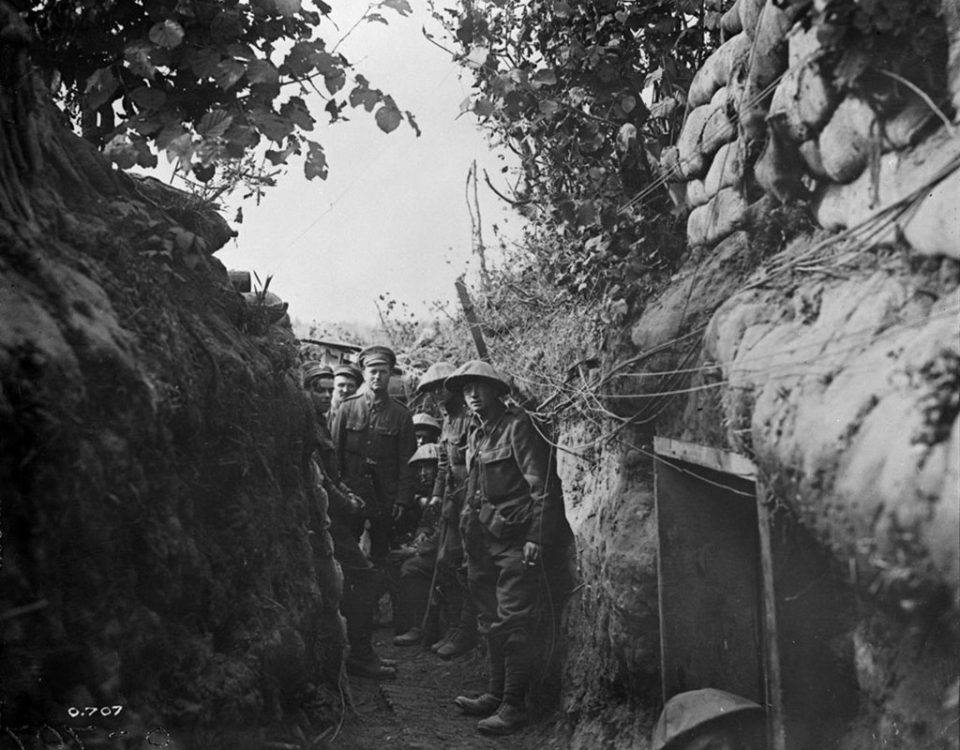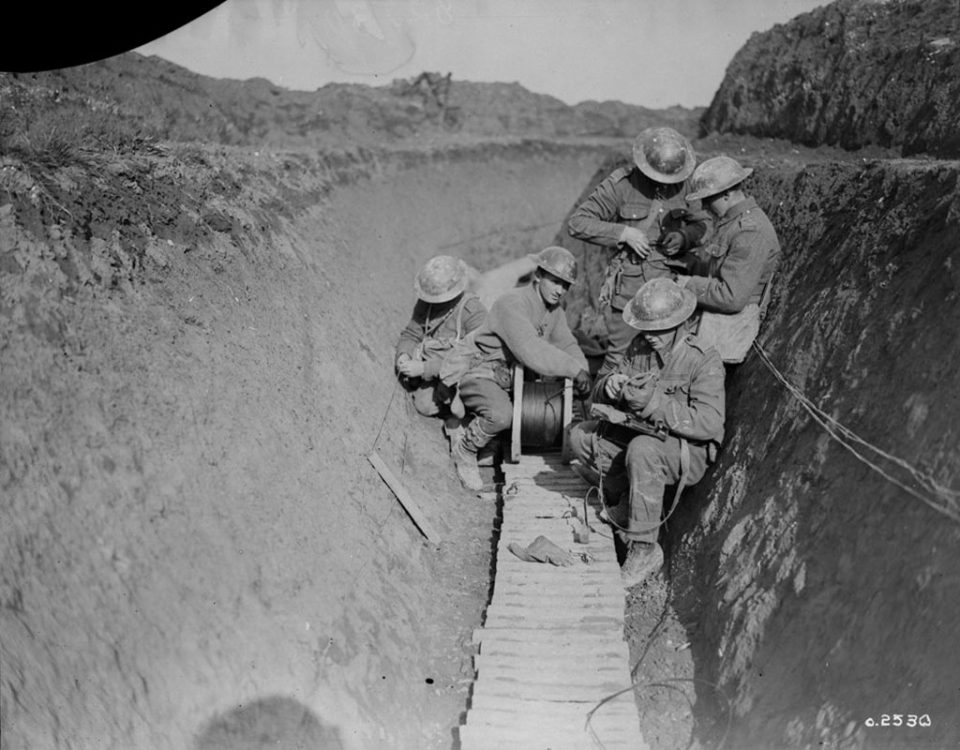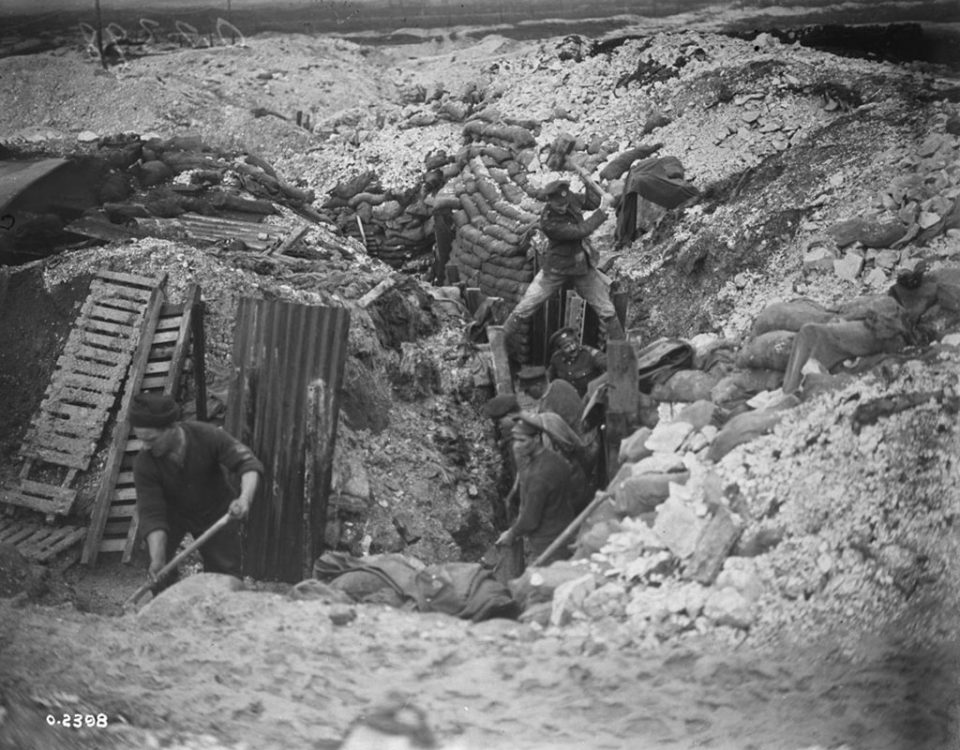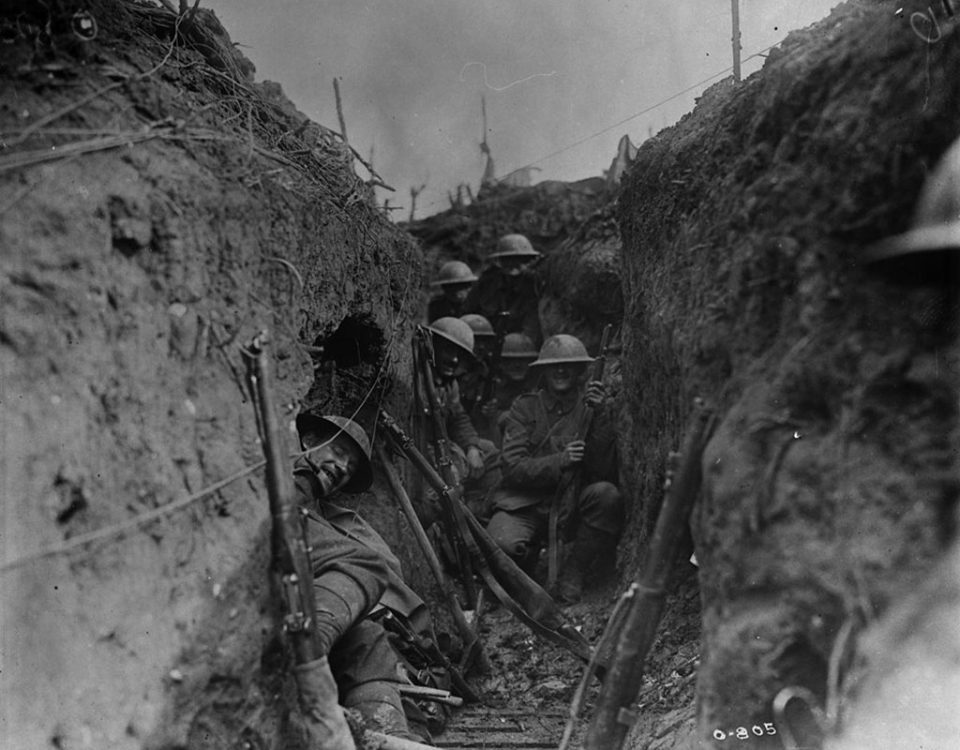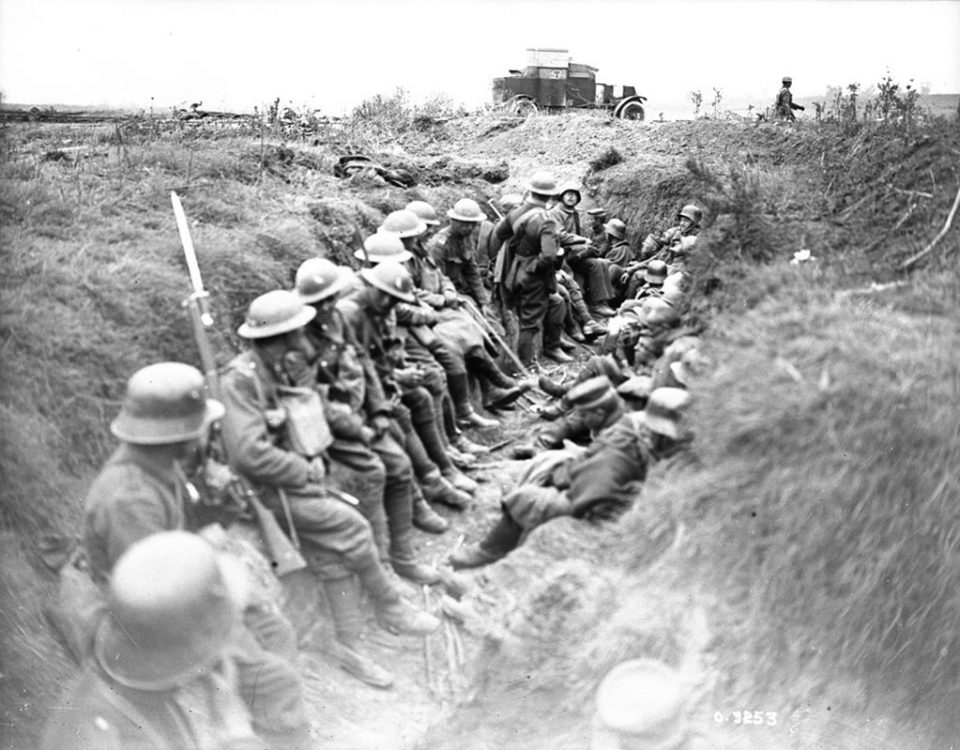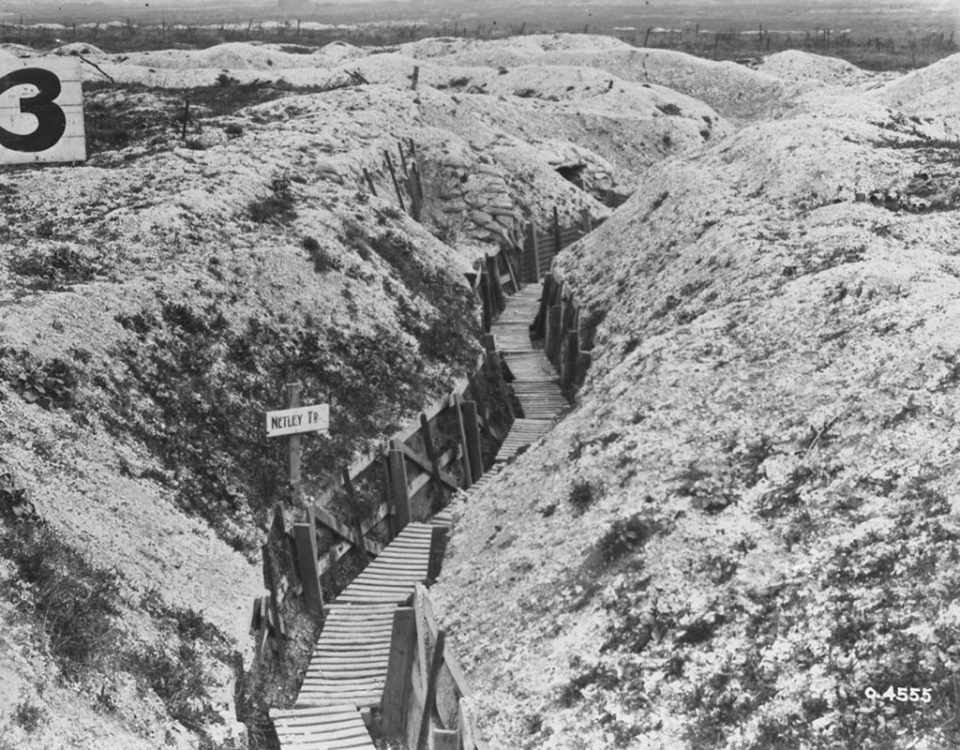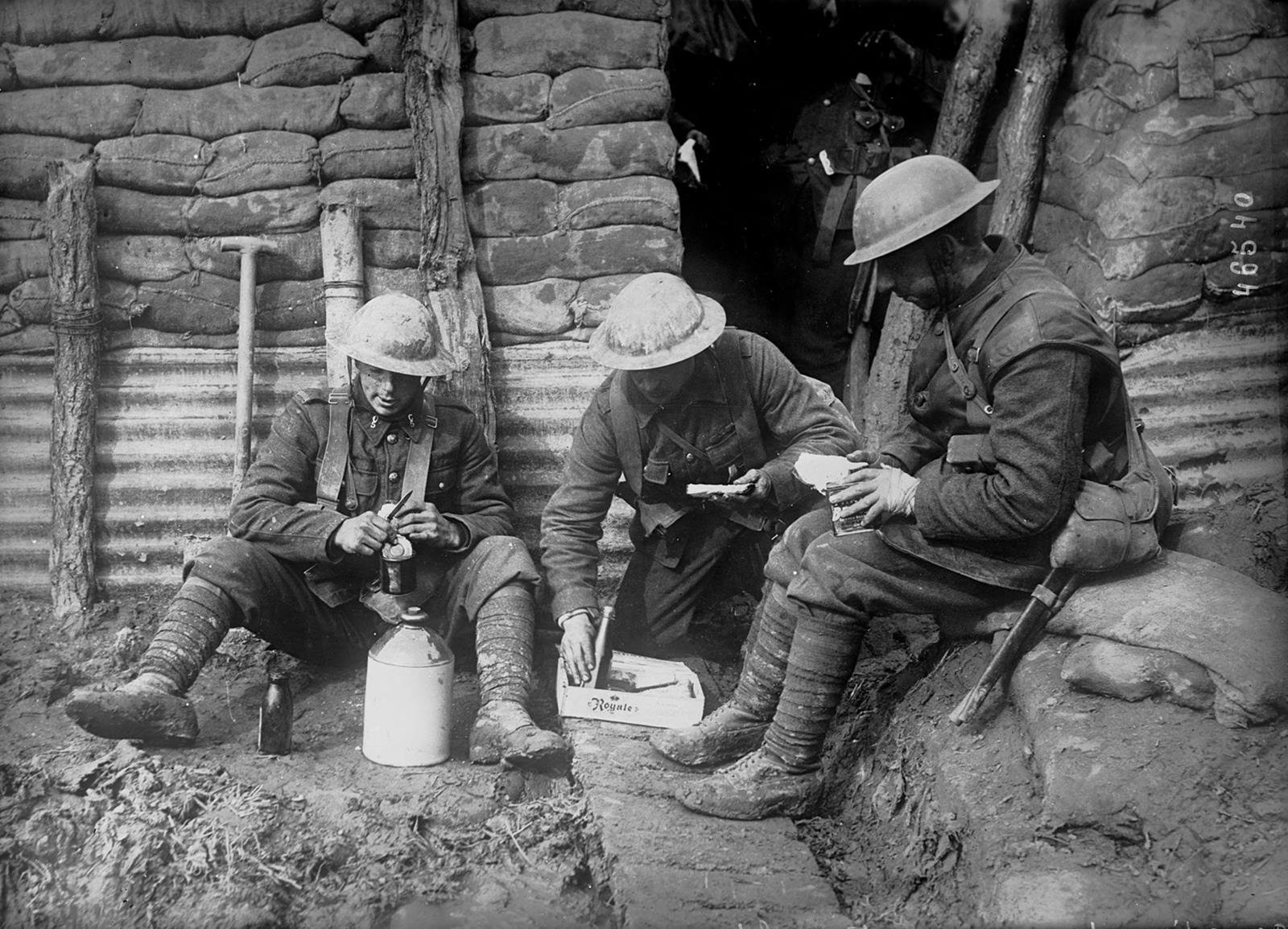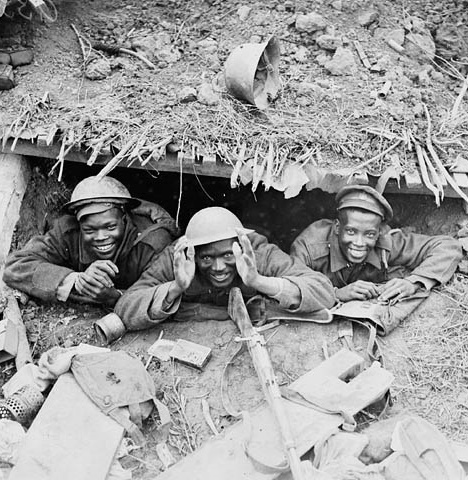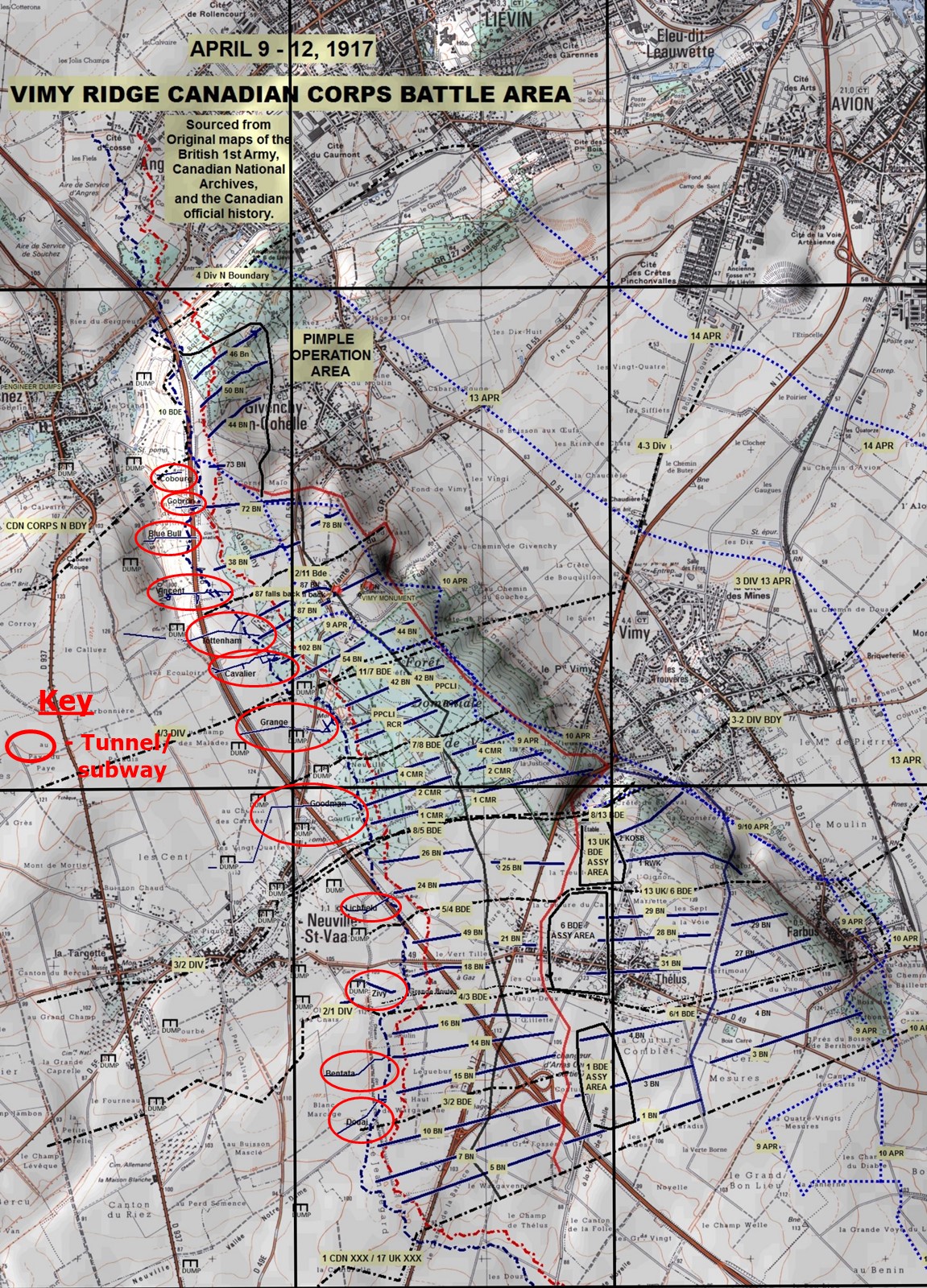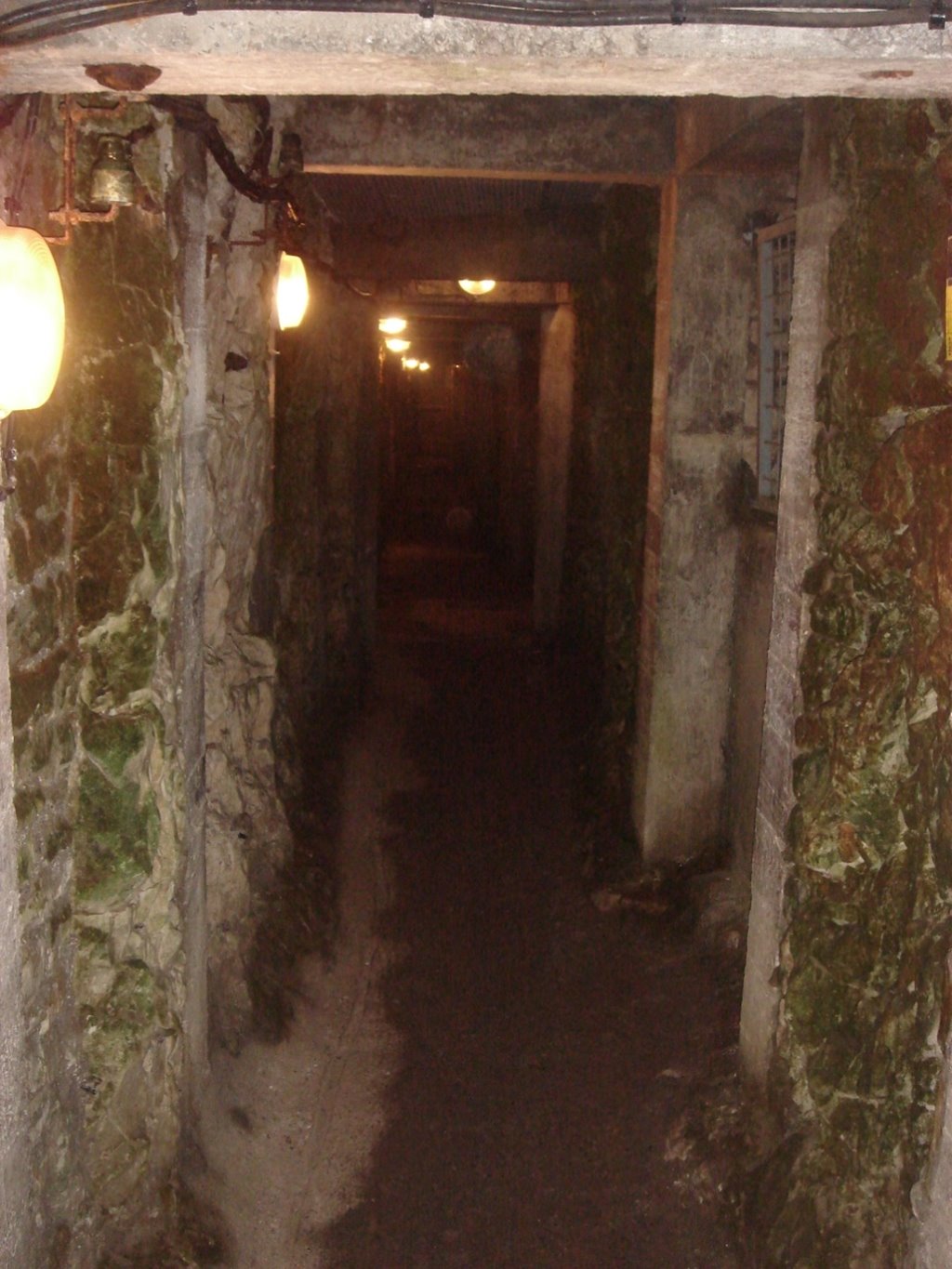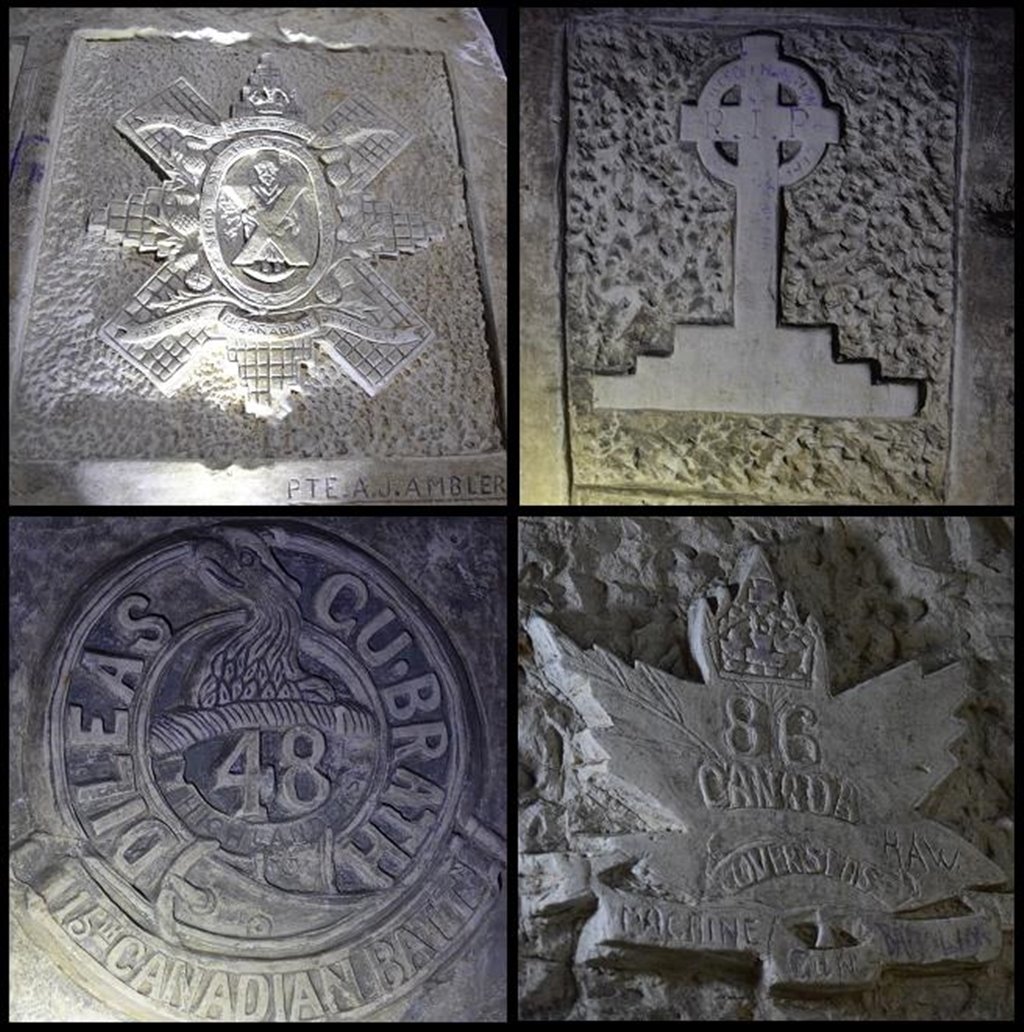Tunnels and Trenches
The complex trench systems characteristic of the First World War were a response to the lethality of modern warfare. Under attack by the powerful weaponry of the industrial age, the only way to survive was to dig in and defend your position. The trenches on the Western Front stretched in an L-shaped pattern from the Belgian portion of the North Sea through France to western Switzerland. This pattern emerged when British Expeditionary Forces and French troops stopped the advancing German soldiers arcing through Belgium and heading toward Paris (known as the Schlieffen Plan). The German advance was stopped at the River Marne, at which point both sides unsuccessfully attempted to outflank each other again and again, extending the trench line until it could go no further upon reaching the beaches in the North. This pattern contributed to the defensive nature of much of the War and resulted in the years-long stalemate and horrendous conditions endured by the soldiers unlucky enough to find themselves in the middle of it.
Trench Structure and Design
The trenches of the First World War were not neatly composed of equally-spaced, straight lines running west from the middle of the continent then turning northwards to the sea. Trenches lay wherever battles forced men to entrench and were often dug by soldiers under fire. Natural features like hills and ridges that could act as defensive assets were incorporated into the fortifications. The opposing sets of adjacent trench systems, one for each belligerent in the fight, each comprised a complex system of earthworks, both trenches and dugouts, that became increasingly complex as the war went on.
The trenches were long, narrow ditches dug into the ground in a zigzagged or toothed pattern to prevent an enemy shooting straight down the length of an invaded trench and to limit the destruction of falling ordnance. Frontline trenches were the closest to the enemy; support and reserve trenches ran parallel to and behind the frontline trench. Connecting the parallel trenches were communication trenches which allowed men and goods to move forward and backward between the lines. Saps extended into the territory between the opposing forces, known ominously as “no man’s land.” These saps acted as jumping off points into the battle or as listening posts.
No man’s land, a strip of death and destruction in places that saw heavy action, was often crisscrossed by barbed wire entanglements intended to funnel soldiers into designated kills zones or to snag and trip them as they ventured across during battle.
Cavities dug underground were known as dugouts. Dugouts could be as simple as earthen rooms which extended some protection from artillery fire or as complex as labyrinthine tunnels and which acted as headquarters, dormitories and operating rooms.
The distance between the opposing trenches varied significantly from several kilometers to mere meters apart. The quality of trenches, and the protection provided by them, varied significantly depending on where they were located, how much forethought and planning went into their location and layout, whether they were dug during battle or not, and the natural features of the land. In some cases, trenches were well-planned, well-developed safe havens for soldiers under fire. In other cases, they were hastily built earthen defenses or at times, little more than shell holes and craters.
Life in the Trenches
The trenches of the First World War were places where diseases (like Trench Foot), lice, and rats flourished. Men lived in these trenches for 4 – 6 days, constantly outside no matter the weather. They rotated their time equally through the front, secondary, and reserve trenches before being moved back from the frontlines. Life in the trenches was both exhausting and tedious. It has been described as hours of boredom punctuated by moments of sheer terror.
The daily routine generally consisted of a one-hour “stand-to-arms” at both dawn and dusk, when it was thought that an offensive was most likely to occur. Men stood on the fire step at the ready during these times, waiting and watching. Daytime was spent draining and repairing the trenches, cleaning and maintaining the latrines and completing any work that could be done in the safety of the trenches. During downtime, men slept, wrote journals and letters home, played cards, or expressed themselves creatively.
At all times while in the trenches, soldiers were at risk of a sniper’s bullet, random shelling, and German trench raids. The continual occurrence of death outside of battle was known as “wastage.” The harsh conditions led to extreme stress, exhaustion, and for some men, shell shock. (Click here for a video example of soldiers suffering from shellshock).
Although relatively rare, some soldiers engaged in malingering, deliberately harming themselves in order to leave the front. In these cases, and other where soldiers were disciplined for various transgressions, harsh punishment could be meted out. Soldier faced minor penalties like fines and having their rum ration taken away for offences like drunkenness. More severe infractions resulted in courts-martial or Field Punishment No. 1, which involved extra labour as well as the humiliation of being strapped to an artillery wheel or post for hours at a time. The harshest punishment of all, for crimes like murder and desertion, was death by firing squad.
The Trenches at Vimy
Visitors to Vimy Ridge today can get a sense of what life in the trenches might have been like by walking through the same frontline trenches the troops did in 1917. However, it is important to remember that these are rebuilt trenches made after the war with concrete duckboards and walls made by filling sandbags with concrete. The Canadian trenches at Vimy Ridge were, in some places, uncomfortably close to German trenches. In certain areas, there was literally a stone’s (or grenade’s) throw distance across a crater between the two front lines.
The Tunnels at Vimy
During the first two years of the war, British and French engineers dug numerous tunnels at Vimy. This was particularly important at Vimy where the German troops who held the ridge were able to see every above-ground movement that their opponent made.
When the Canadians arrived in December of 1916, not only was the surface heavily battle-scarred, the earth underfoot was a labyrinth of tunnels, some of which were 35 metres below the surface. Each of the passageways inherited by the Canadians represented a previous Entente attempt to undermine their German opponents. The idea was to dig under them, fill the new tunnel with explosives, and then set off the charge. The ultimate goal was to either blow up the German trenches or to severely damage their strong points so that Vimy Ridge could be taken. Unfortunately, at Vimy and at many other mining locations, the most frequent result was a huge crater that would act as an obstacle to soldiers on both sides as the fighting progressed.
This subterranean war zone was expanded during the Canadians’ stay at Vimy with the help of British Tunneling companies. The mining work was very stressful for all engineers and sappers because the digging needed to be completed as silently as possible. Sappers from opposing sides would set up listening devices in their own tunnels that served to pinpoint enemy mines which, once found, would be blown up by specifically placed explosives.
Prior to the Canadian attack on April 9th, 1917, records show that the Canadian Corps had around 1 000 men working on 12 underground passageways (aka subways). Each of the tunnels housed soldiers, ammunition, water, and communication lines, and most were lit by electricity. The Canadians used these passageways before the Battle of Vimy Ridge as a way to protect soldiers as they moved to the front line.
The majority of the tunnels were shorter than 500 metres in length, but a few were longer, including the Goodman Subway (1 200 m). Some also had massive rooms linked to the main passageway; the Zivy Subway had a side room that was large enough to hold more than 300 soldiers.
Although the subways at Vimy offered many amenities to the soldiers while protecting them from the artillery shells, gas, and bullets above, the possibility of being discovered by the enemy as well as the small dimensions of the tunnels led many soldiers to dislike being underground and some developed feelings of claustrophobia. For those who would like to experience the Vimy underground today, it is possible to take guided tours through the 0.8-kilometre-long Grange tunnel.
Living Underground at Vimy
Large and small rooms off of the passageways served as medical facilities, offices, dormitories, bathrooms, and kitchens. Although the subways often had electricity, piped water, phone lines, and provided protection from artillery fire, they were prone to leakage, poor air quality, and were unpleasant to be in for any great length of time.
Carvings in the Chalk
Many Canadian troops left their mark in the tunnels and dugouts at Vimy.
It is interesting to note that although the Canadian Maple Leaf is a common symbol found in the underground graffiti, it was not yet the symbol on the national flag of Canada.
Just as the identity of Canada as a nation was developing during the First World War, so was the maple leaf as a symbol Canadians identified with.
To play an online game that is a realistic illustration of life in the trenches, please click here: Over the Top
Unit Home
Gearing Up: Vimy Battlefield. Wasteland and Ruins. Open Cemetery. War in the Air.
Byng and Currie
Julian Byng. Arthur Currie. Byng's Boys. Guts and Gaiters. Currie Video.


